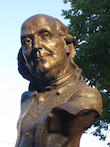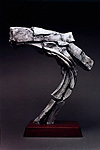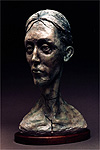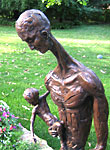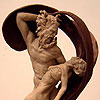 > Keys To Community > Location
> Keys To Community > Location
The Sculpture's Location

The land where Keys To Community sits — now called Girard Fountain Park on Arch Street — has been occupied for several hundred years.1 (See views from ca. 1799, 1960, and 2000.)
1600s-1700s
The thoroughfare it overlooks was called Holmes Street in the earliest property deeds on record. Pennsylvania founder William Penn renamed it Mulberry Street.2 But locals were far more likely to call it Arch Street after the bridge that crossed it at Front Street, two blocks from the Delaware River docks.
"4th and Arch was on the outer edge of the city during the 17th and 18th centuries," part of the so-called Mulberry Ward, a working-class part of the city where "the smallest and least valuable houses" might be found.2 Unlike nearby blocks, the addresses on the north side of Arch between 4th and 5th began at 123 Arch and rose to the east.
The flavor of the neighborhood after the American Revolution may be found in Philadelphia's earliest street directories (indeed, the earliest ones in the United States). First published in 1785 and 1791 by Clement Biddle, the directories by 1795 describe the north side of the next block west as "occupied by a rather democratic collection of residents. There were hatters, skin dressers, bakers, a brass founder, boarding houses, school teachers and a hair dresser, as well as a physician." 2
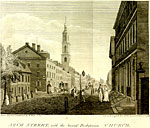 A William Birch engraving from about 1799 shows a three-story, three-chimney building on the spot. This is likely 127 Arch, a house built around 1791 for Catharine Kepley (or Kepple) by one Francis White. (The house is the large on on the left; the view is east on Arch Street across 4th Street.) Just next door to the site is Loxley Court, assembled from various plots purchased by carpenter Benjamin Locksley near 319 Arch. Some accounts place Franklin in this courtyard for his famous kite-and-key experiment; it seems certain that he was at least a frequent visitor. In 1799, the block was graced by George Washington's funeral procession, which came down this block, turned onto 4th Street, and entered Zion Church.2
A William Birch engraving from about 1799 shows a three-story, three-chimney building on the spot. This is likely 127 Arch, a house built around 1791 for Catharine Kepley (or Kepple) by one Francis White. (The house is the large on on the left; the view is east on Arch Street across 4th Street.) Just next door to the site is Loxley Court, assembled from various plots purchased by carpenter Benjamin Locksley near 319 Arch. Some accounts place Franklin in this courtyard for his famous kite-and-key experiment; it seems certain that he was at least a frequent visitor. In 1799, the block was graced by George Washington's funeral procession, which came down this block, turned onto 4th Street, and entered Zion Church.2
1800s
Light industry made its way into the neighborhood during the first half of the 19th century. Around 1850, F.C. Key and Sons, a die-stamping concern, moved into 123 Arch. The new firm was just three years old when Mulberry Street was formally renamed Arch to follow popular usage,5, and a few more when the street's west-to-east addresses were reversed to follow the nearby blocks: in 1857 or 1858, and F.C. Key began getting mail at 329 Arch Street.6 One of the sons, W.H. Key, took over the business, renamed it the Ornamental Medal, Seal, and Die Makers Co., and in 1865, issued a commemorative coin depicting Lee's surrender to Grant. By century's end, the northeastern corner of 4th and Arch was occupied by four 3- and 4-story commercial buildings.10
1900s
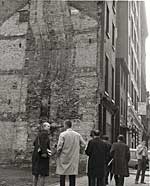 By 1935, trolley tracks ran down the center of Arch Street, symbol of a mature industrial center.9 The corner began a new change in the mid-1960s, when the commercial buildings were torn down. Replacing them were a Philadelphia Fire Department firehouse (Engine 8 and Ladder 2) and a small piece of land that would become a 0.15-acre vestpocket park. In 1967, brick walls were constructed around the north end of the park, blocking it off from Loxley Court; and the south end, constricting access to Arch Street.11 In 1971, the city installed Penny Franklin (photo), an acrylic sculpture by local artist Reginald Beauchamp that was covered with 80,000 pennies. The sculpture was taken down in 1996 after it began to deteriorate. The park fell into disrepair as well, and was eventually closed to public access.
By 1935, trolley tracks ran down the center of Arch Street, symbol of a mature industrial center.9 The corner began a new change in the mid-1960s, when the commercial buildings were torn down. Replacing them were a Philadelphia Fire Department firehouse (Engine 8 and Ladder 2) and a small piece of land that would become a 0.15-acre vestpocket park. In 1967, brick walls were constructed around the north end of the park, blocking it off from Loxley Court; and the south end, constricting access to Arch Street.11 In 1971, the city installed Penny Franklin (photo), an acrylic sculpture by local artist Reginald Beauchamp that was covered with 80,000 pennies. The sculpture was taken down in 1996 after it began to deteriorate. The park fell into disrepair as well, and was eventually closed to public access.
2000s
In the early years of the new century, neighborhood residents Joseph Schiavo and Janet Kalter led the effort to bring the park back to life, investing hours of labor to clean the land up and install new benches and tables. On Oct. 5, 2007, the city and Fire Department dedicated Keys To Community, bringing new life to the corner. The park was reopened under the name Girard Fountain Park, under the care of the Fire Department. The nearby Firemen's Hall Museum, which helped raise funds for Keys To Community, is turning its attention to the currently inoperable fountain just behind the sculpture.
View Larger Map
Nearby
Directly across 4th Street stood a building with the sign "C. A. BROWN & CO. / CHEAP BOOK STORE," from before 1847 until it was torn down around 1854 and replaced with the more formidable five-story iron-and-brick Ketterlinus Printing House. That iron-and-brick structure stood until Ketterlinus replaced it in 1905 with the "largest reinforced concrete structure in Philadelphia."2 That building and its neighbor, the Curtis Publishing Co. (located at 421-7 Arch and constructed between 1896 and 1901) that produced Ladies' Home Journal and the Saturday Evening Post, were replaced in 1966 with by the U.S. Mint, the world's most prolific coin-producing facility.4
On the south side of Arch Street stands the Arch Street Friends Meeting House, the oldest and largest Quaker house of worship in the world. Its land was donated by William Penn in 1701 and used for a century as a burial ground. Many victims of the yellow fever epidemic of 1793 are buried here, as is Samuel Nicholas (1744-90), the first commandant of the U.S. Marine Corps. The Meeting House was built in 1803.5
From 1751 to 1801, a plot on the southwest corner of 4th and Arch was occupied by an educational institution called The College, Academy and Charity School, which would eventually move and become the University of Pennsylvania.2
References
- "Birch's Views: Arch Street, with the Second Presbyterian Church," ushistory.org, retrieved 13 October 2007.
- A Glimpse into the History of the 401 Block of Arch Street, Philadelphia. Anna Blinn and Claire Mahler, 2005: The Surrounding City. A project for "Field Techniques: Places in Time (Growth and Structure of Cities 306)" at Bryn Mawr College. Retrieved 13 October 2007.
- Blinn and Mahler, "The Corner."
- Blinn and Mahler, "The Block."
- "Spaces, inside and outside, in Eighteenth-Century Philadelphia" by Sharon V. Salinger; Journal of Interdisciplinary History, Vol. 26, No. 1 (Summer, 1995), pp. 1-31. Cited by Blinn and Mahler.
- Pg. 33, v.1, Jane Campbell Collection, Historical Society of Pennsylvania. Cited by Blinn and Mahler.
- "Late and Former Names of Streets of the Old Districts of Northern Liberties, Kensington, Port Richmond and Spring Garden," ushistory.org, retrieved 13 October 2007.
- ushistory.org, retrieved 15 October 2007.
- University of Notre Dame coin collection, retrieved 15 October 2007.
- Early Philadelphia: Arch Street, originally Mulberry Street, retrieved 15 October 2007.
- Trolley tracks in 300 block of Arch, 1935, Photo, PhillyHistory.org, retrieved 28 October 2007.
- Corner of 4th and Arch, 1959, Photo, PhillyHistory.org, retrieved 28 October 2007.
- Scar on 323 Arch Street Photo from PhillyHistory.org: "Inspection of Loxley Court & West wall of building once adjacent to 323 Arch Project:321-323 Arch Street. Mrs. Kirkbride with officials of the fire station pleading for a lower brick wall across its 'Garden.'" Retrieved 29 Oct 2007.
Contact
Send email to: james AT jepsculpture.com
Copyright © 2000-2018 James Peniston

